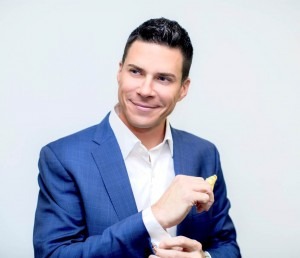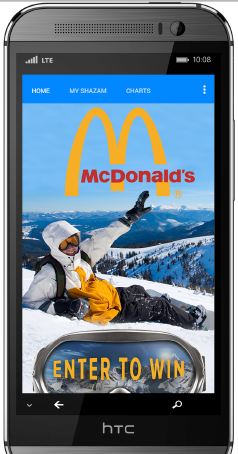Many don’t remember that Shazam originally started as an SMS service. A consumers could dial 2580 on their mobile phones, hold it up to a speaker and receive a text message showing the song title and name of the artist that was playing.
Shazam has come a long way. It has become famous in its mobile app form, connecting more than 500 million people to the music and televised content around them. Many remember first downloading the app on a smartphone, amazing and amusing friends with the ability to Id songs in restaurants, bars, or anywhere.
Shazam was from an overnight success. To put its usage in perspective, it took ten years for the service to reach 1 billion tags and just three months to go from 10 to 12 billion.
But while a great many of those tags were inquiries about songs people heard on the radio, Shazam’s relationship with the industry has been one way, until now. Shazam for Radio is a platform developed by CEO Jason Bailey and the team at Sun Broadcast Group enabling stations to interact with Shazam in a number of valuable ways. For this edition of Radio’s Most Innovative, we asked Bailey to tell us more about how the innovative Shazam interfaces with radio.
 JM: How did the partnership with Shazam come together?
JM: How did the partnership with Shazam come together?
JB: In early 2014 while getting ready for work, I was watching the “Today Show” and saw the team making a delicious Super Bowl recipe. I don’t cook but I wanted to make that recipe. I didn’t have a DVR in my bedroom or pen and paper, so I could only stand there and imagine how great it would have tasted as they went to commercial.
But that recipe kept swirling around in my head. I thought there must be a way I could have gotten everything I needed without writing it down or recording it. I picked up my phone to look for a “Today Show” app but stopped at the home screen and stared at my Shazam app. Why couldn’t Shazam pick up the audio and send the related info – the recipe — right to my phone? That’s when the idea for Shazam for Radio was born.
Then all I had to do was… convince Shazam. After months of talking to stations, programmers, and developers, I finally sat down with Shazam CEO Rich Riley. Within just a few minutes he got the idea and saw the potential for interactive, live broadcast radio.
What I believe ultimately sealed the deal was our mutual desire to do one thing: create magic for our users. I had no idea if the product would be sellable, profitable, or how to pay for it. But all I cared about was creating that moment for listeners when their phone magically loaded all kinds of information without jumping through hoops.
Listen to your radio at home, in the car or at work. Your phone hears content that’s “Shazamable” and it instantly brings the broadcast to life. It’s magic. And that’s exactly what drives Shazam; magic for their users.
JM: What has been the most difficult part of rolling the service out to broadcasters?
 JB: We needed to explain that Shazam is a partner to radio, not an adversary. Broadcasters were disappointed that when you Shazamed a song you were offered a chance to listen on Pandora or Spotify. All I heard early on was “Why do I want to do business with a company that takes listeners away from my product?” That was frustrating because, if you look at Shazam just a little bit differently, it can be a huge asset. Give listeners content beyond songs they want to Shazam and they will keep coming back to get more.
JB: We needed to explain that Shazam is a partner to radio, not an adversary. Broadcasters were disappointed that when you Shazamed a song you were offered a chance to listen on Pandora or Spotify. All I heard early on was “Why do I want to do business with a company that takes listeners away from my product?” That was frustrating because, if you look at Shazam just a little bit differently, it can be a huge asset. Give listeners content beyond songs they want to Shazam and they will keep coming back to get more.
Even now, many stations still don’t understand that Shazam is like Facebook, Twitter, or Instagram; a social platform with over three quarters of a billion devoted users worldwide that can finally be accessed by radio. With almost 200 million U.S. users, Shazam has almost the same reach as our entire industry. Why wouldn’t we want to use this platform to better our product?
JM: How does the service differ from a station mobile app and how do they work together?
JB: This was another challenge we faced early on; many groups said they already have a station app. But Shazam for Radio is not the same at all. Station apps are there when people can’t listen to broadcast radio; when they’re at home, in the car, or at work.
Shazam is for taking the real, live broadcast radio and making it visual and interactive. Once the listener arrives at the Shazam screen, broadcasters can take them to their other products. I like to say Shazam is a highway for radio to drive people to the next experience: Facebook, Twitter, call in, website, client’s website, apps, contest entry, etc. And the entire time Shazam helps them engage longer with your brand through deep, dynamic content.
JM: There’s a lot of data available for broadcasters from Shazam. What would be most interesting for programmers?
JB: This was one of the biggest upsides that I saw immediately and I am still trying to explain it to people today. Station apps, websites, mobile listening are great for capturing data, but until Shazam for Radio, we had no way to learn more about people listening in the car, at home, or at work. We only know broadly what groups listen and what they may or may not like.
With Shazam, not only do we capture everything a person touches on the screens we create, but we can also get insight into what they do when they leave. What other music do they Shazam? What genres of music are in their iTunes? What advertisers or TV shows do they Shazam? Where are they? What time are they likely to Shazam? At what point during a piece of content do they decide they’re interested enough to Shazam? There are SO many data points that we collect on the individual users that finally allow stations to see deep into the life of their listeners and use that data to program to their audience.
JM: Creating additional content for people who Shazam the station is a great idea but requires time and personnel. How does your team assist with that?
JB: We knew station resources were limited and dumping another product in their lap that requires hours of backend work would have been a failure. Shazam for Radio is totally turnkey. Our team can design, build, code, and launch campaigns. We also built our client platform which allows stations to manage the process as much as they wish. We even travel to every market we activate and hit the streets with the sales team to assist with selling the product before it goes live!
JM: What are the sales applications for stations using the product?
JB: The capabilities of this product are truly endless. What comes up on a Shazam screen is basically HTML code, which means we can do anything. Video streams, replay audio, live social media feeds, store locators, couponing, app downloads, there isn’t a thing we can’t accomplish.
An example below:
JM: Talk more about the integration of station contesting with Shazam.
JB: It’s been more successful than we honestly could have imagined. Remember, we first have to get people to understand that they can now Shazam things other than songs which we knew would be a long process. Nevertheless, the results have been outstanding.
For example, WTMX/Chicago gave away tickets to Lollapalooza and the only way to enter was to Shazam the station promo. Not only did more than 5,000 people Shazam the promo and enter, they stayed in the Shazam screen — the Mix Lollapalooza experience — for almost 2 full minutes. They looked at the lineup, got access to videos and special content, listened to songs by the performers, and then connected with the station’s social media. And all of that resulted in valuable data from people listening to broadcast radio which WTMX would have never been able to collect with call-in or text contesting. In comparison, the average Shazam song experience lasts about fifteen seconds. We used radio to engage the user almost five times as long.
An example below:
JM: Are there any other innovations you’ve seen recently in or around the radio industry that captured your attention?
JB: I always take this opportunity to highlight one product that I think is very good for broadcast radio and that’s (Emmis CEO) Jeff Smulyan’s NextRadio and the effort to get FM radio on mobile devices. I know it has a long road ahead, but they’ve been making amazing strides which I believe are commendable.
NextRadio excites me for the same reason as Shazam for Radio: it’s one of the few products centered completely on live, over-the-air, broadcast radio. Putting real, live radio (not streaming) into more hands and in more places is a good thing, and as far as I can see, Jeff is the only one working his ass off to do that.
JM: Innovation is difficult. What advice do you have for someone who has a great idea for the radio industry but isn’t sure how to start building it?
JB: Have patience! Now more than ever, have patience, especially in this industry. In the last 5-10 years radio has become very closed-minded. Groups want to go it alone or are scared to take chances. It’s my biggest frustration after 22 years in the space. From programming options to new digital tools, it takes an act of God to get a group to pay serious attention to you. And, if you want inventory, you better buckle in and hope the morning guy leaves so you can get one of the barter minutes from his comedy service(s). But all hope is not lost. Despite being the youngest network CEO, I’m in this space for the long haul and see great days ahead for my mission. Good products that make stations money or increase audience will prevail.
And I see a day where we get back to more small groups and locally owned stations which means more open minds willing to take chances and try things. That is the day that should excite innovators. So hang in there. Innovate! Our industry desperately needs you and I’ll be the first one to listen.
Thanks to Mike Stern for writing this week’s Radio’s Most Innovative.
INNOVATION QUOTE OF THE WEEK
“I can’t duplicate my own successes, because part of the creation of that effect is making something happen you didn’t expect.”
Brian Eno
More of Radio’s Most Innovative
- Radio’s Most Innovative: All Christmas Music
- Radio’s Most Innovative: Joel Denver/All Access
- Radio’s Most Innovative: Lee Abrams
- Radio’s Most Innovative: WTOP Digital
- Radio’s Most Innovative: KCSN’s Remote Studio and Performance Space
- For Radio, Will It Be Christmas In April (And Hopefully, May)? - April 21, 2025
- Media And Technology In 2025: Believe It Or Not! - April 18, 2025
- In Radio, You Just Never Know - April 17, 2025





Leave a Reply